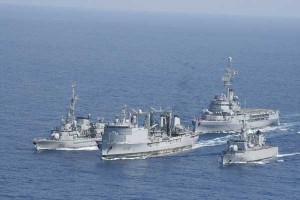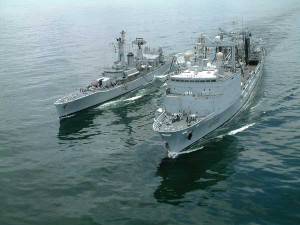 In addition, priorities should have been focused to establish training facilities for officers and ratings in modern, sophisticated weapons systems and marine engineering and electronics along with basic seamanship. The existing naval establishment could have been suitably refurbished to orient its equipment and training for the seaward defence of the coastline in general and our major ports in particular. Later, the capability could have been progressively enhanced to extend offensive operations against enemy ports and installations. A few modern and prestigious warships could be acquired fitting in with the program, to fly the Indian flag in neighboring waters if politically required. But that was not to be.Instead, the Parry program, sponsored by ignorant bureaucrats, got underway in 1948. One LST and six LCTs were retained for the day when we could prepare for landing operations needed in the future, a wasteful expense and effort for a farfetched task. A light cruiser and three R class destroyers were bought from Britain in 1948, the cruiser arriving by the end of the same year and the destroyers in January 1950 after refitting. Two oilers were also acquired along with them. Of the old fleet, four trawlers and six minesweepers had to be discarded because they were no longer seaworthy, thus keeping the overall strength of the Navy almost constant. The nucleus of the future fleet air arm was planned to be created to receive the first aircraft carrier, which was scheduled to arrive sometime in 1955.
In addition, priorities should have been focused to establish training facilities for officers and ratings in modern, sophisticated weapons systems and marine engineering and electronics along with basic seamanship. The existing naval establishment could have been suitably refurbished to orient its equipment and training for the seaward defence of the coastline in general and our major ports in particular. Later, the capability could have been progressively enhanced to extend offensive operations against enemy ports and installations. A few modern and prestigious warships could be acquired fitting in with the program, to fly the Indian flag in neighboring waters if politically required. But that was not to be.Instead, the Parry program, sponsored by ignorant bureaucrats, got underway in 1948. One LST and six LCTs were retained for the day when we could prepare for landing operations needed in the future, a wasteful expense and effort for a farfetched task. A light cruiser and three R class destroyers were bought from Britain in 1948, the cruiser arriving by the end of the same year and the destroyers in January 1950 after refitting. Two oilers were also acquired along with them. Of the old fleet, four trawlers and six minesweepers had to be discarded because they were no longer seaworthy, thus keeping the overall strength of the Navy almost constant. The nucleus of the future fleet air arm was planned to be created to receive the first aircraft carrier, which was scheduled to arrive sometime in 1955.
Our Navy was not even able to support a battalion amphibious operation adequately in the Bangladesh operations.
The Parry plan envisaged the acquisition of two aircraft carriers. Carriers usually provide air support on the seas when a fleet operates outside the range of shore based aircraft, particularly applicable to greater powers while operating in distant overseas theatres. In the context of Indian coastal defence, it would have been preferable to develop air bases at suitable locations along the coast from where our Air Force could provide the requisite support of the Navy operating off the coastline rather than acquire aircraft carriers for a role which could be easily carried 0ut by the land based IAF. This was a wasteful duplication of effort which could have been usefully utilized by meaningful enhancement of other naval capabilities. Instead, the first carrier was phased to arrive in 1955 and the second in 1957, by which time it was hoped that the fleet air arm would comprise 300 modern naval fighters, fighter-bombers and anti-submarine aircraft with a frontline operational capability of 54 aircraft in two carrier groups.
Luckily for India, lack of internal financial resources and the Korean War on the international horizon slowed the execution of the Parry plan. Britain could not release the required war-ships at the pace envisaged by the Indian naval program, and the country’s foreign exchange reserves were needed badly for the government’s development plans. As a result, wisdom dawned on the authorities to have a second look at the Parry plan and re-tailor it to suit immediate resources and needs.
Parry himself announced at a press conference that the Indian Navy was now committed to develop a small carrier task force .of the hunter-killer (antisubmarine) type that would consist of one light fleet carrier, three light cruisers, eight to nine destroyers and the necessary support vessels. Its composition was oriented once again to destroying submarines on the high seas. It was a matter of conjecture which nation posed such a threat to India’s negligible shipping at that time.
The naval planners projected the British Admiralty view, which visualized the Indian Navy only as a component of a wider Commonwealth naval presence in the Indian Ocean.
In accordance with the revised program, India proceeded to purchase a fleet replenishment ship from Italy and to borrow three ex-escort destroyers of the Hunt class from Britain. A second light cruiser, later named INS Delhi, was purchased in 1954 and underwent extensive refitting before actually joining the fleet in 1957. Two inshore minesweepers also came from the Royal Navy.1 In 1955, a six-year building program for the Navy began in a big way in British shipyards. In this period the Navy expected 12 antisubmarine and antiaircraft frigates, eight coastal minesweepers and an unspecified number of inshore minesweepers.
The number which actually materialized was two coastal minesweepers, five antisubmarine frigates and three antiaircraft frigates. Perhaps it was a blessing in a way that the acquisition fell short of the planned target as the naval program bore no relation to India’s immediate needs. The acute shortage of foreign exchange, which involved a deficit of 8650 million in 1957-58 and threatened to derail the Second Five-Year Plan, forced the Government to cut short the naval building program in Britain. It however purchased the three R class destroyers on loan and in service with the Indian Navy. A decision was taken instead to create facilities to build our requirements in Indian shipyards.
The first naval air station-INS Garuda, a shore based training establishment-was commissioned in 1953 at Cochin. The same year, ten short-flight Sealand amphibious craft, and in 1955 the Fairey Fly craft, were acquired to get the Navy into the air. Later, the Hindusthan HT-2 and Vampire trainers ushered in the jet age in IAF. The Royal Navy’s Hercules, a light-fleet carrier, was purchased in 1957 and joined the fleet in 1961 after thorough refitting and modernization and was rechristened INS Vikrant.
Also read: The Madhesis of Nepal
A few months later, a squadron of American Sea Hawk jet fighter-bombers and another squadron of French Alize turbo-propelled aircraft for reconnaissance and antisubmarine work, joined the Vikrant. Although the initial naval program envisaged the establishment of a submarine arm, this was given lower priority. Financial constraints prevented the acquisition of submarines and forced the Navy rely on periodic visits by British submarines for training in antisubmarine operations. The first Indian Naval Chief, Vice Admiral RD Katari, stated in May 1962 that the Navy was dissatisfied role and publicly pleaded for early establishment of its own submarine fleet.
 Along with the expansion of naval strength, the Navy strove to develop its own training establishments to replace those retained by Pakistan on partition. Until 1952, all naval officers were sent to Britain for training , but by 1955 India has created adequate training facilities to meet most of the Navy’s basic needs. The number of men sent to Britain gradually declined. Concurrently, Indianization had also gone well ahead, and by April 1962 the Indian Navy became entirely national in character. Not a single foreigner was borne on its strength in any capacity.
Along with the expansion of naval strength, the Navy strove to develop its own training establishments to replace those retained by Pakistan on partition. Until 1952, all naval officers were sent to Britain for training , but by 1955 India has created adequate training facilities to meet most of the Navy’s basic needs. The number of men sent to Britain gradually declined. Concurrently, Indianization had also gone well ahead, and by April 1962 the Indian Navy became entirely national in character. Not a single foreigner was borne on its strength in any capacity.
Notes:
- Asian Recorder, Vol 1, No 51, “Navy’s Progress,” p. 579.
With the commissioning of the Vikrant in August 1961,1 the naval requirement and expansion program was completed. According to Vice Admiral BS Soman, then Chief Staff, the Navy comprised 50 warships of all types manned by 1,450 officers and 14,550 ratings. The fleet was based in Bombay and Cochin on the west coast, and according to one official spokesman constituted the most effective naval force of any country in the Indian Ocean region.
Its ships were entirely of British origin with the exception of the fleet replenishment ship. The Savitri class seaward defence boats were a mixed lot, Italian,. Yugoslav and Dutch. A Portuguese frigate, captured in the Goa operations in 1961,2 also sailed under the Indian flag. Apart from these, there were a few smaller craft built in Indian shipyards. The force was greatly dependent for spares, repairs, training and other facilities on the Royal Navy, but this was understandable in view of the leading British role in its development. Aircraft for the naval air arm were selected purely on performance and cost effectiveness.
 India’s maritime trade was still conducted in foreign ships, mostly belonging to the Western bloc, as an understanding on trade and commerce had not yet developed between Indian and the Communist countries. As a result New Delhi looked upon the security of the Indian Ocean sealanes as the overall responsibility of the Western nations and the nonaligned regional states of the Commonwealth. Everything had so far worked out well for Nehru’s nonalignment policies.
India’s maritime trade was still conducted in foreign ships, mostly belonging to the Western bloc, as an understanding on trade and commerce had not yet developed between Indian and the Communist countries. As a result New Delhi looked upon the security of the Indian Ocean sealanes as the overall responsibility of the Western nations and the nonaligned regional states of the Commonwealth. Everything had so far worked out well for Nehru’s nonalignment policies.
The threat from China, although developing fast on the land frontier, had not much potential in the Indian Ocean. The Indonesian Navy was fast expanding in numbers and quality with Russian help, and this had emboldened President Sukarno to claim the Nicobar Islands. But this did not constitute a threat of any significance and was treated as part of Sukarno’s empty “bellicosity.” Under the circumstances, Indian naval power was reduced to an adjunct of Commonwealth-United States defence of the Indian Ocean region. Although politically not contributing to any East-West confrontations, India allowed its Navy to participate in annual exercises with other Commonwealth navies in the ocean. In this period, contingency planning was to meet only the threat from Pakistan. Pakistan’s naval capability was extremely limited at the time, with the operational responsibility of guarding the coastline of two wings of the country separated by about 3,000 miles of sea.




